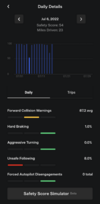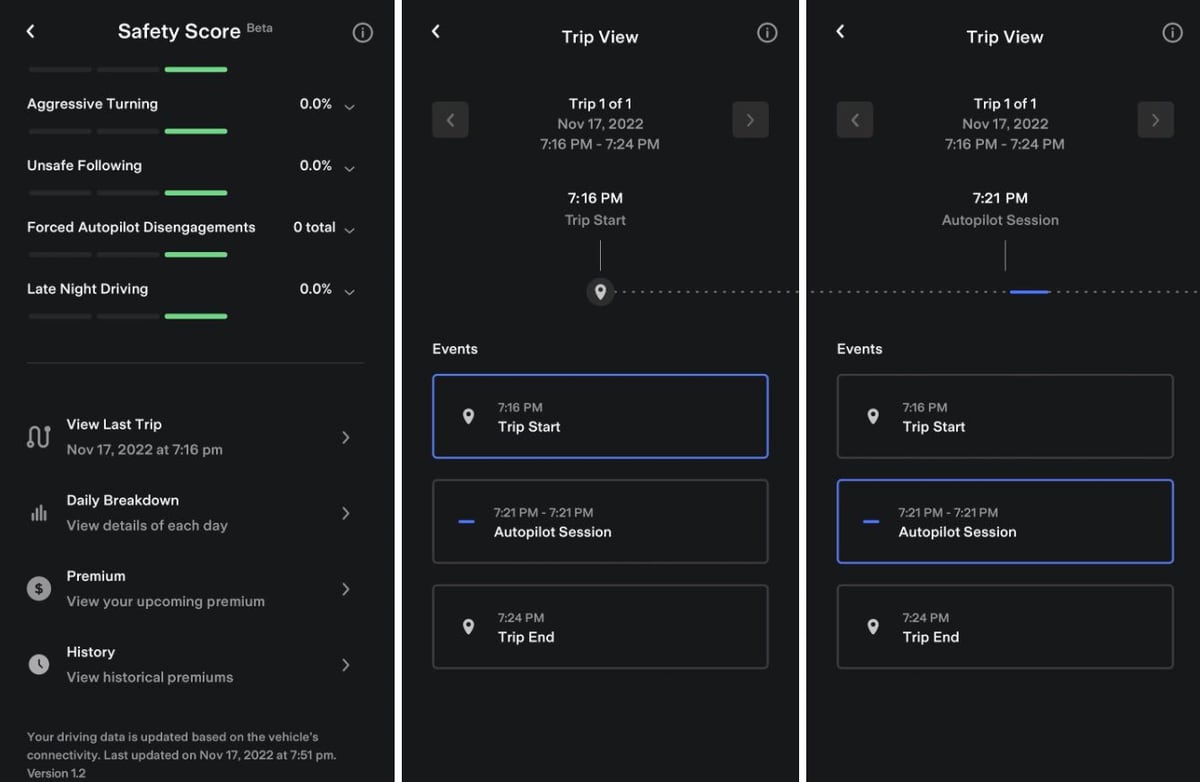There is no TLDR; when it comes to this. there is no one piece of advice. If you're interested, please give my experience and advice a read.
I've seen many, many, many, people complain about the safety score program. and most of the time, it's due to just not understanding the process required to do well. Hopefully this helps people and they don't just argue like everyone seems to love. I've now driven 21,500 miles with a safety score since opting in 1/5/22. My first month of learning my car and the score system, I had a 97. As scores rolled off, In the second month, I hit 100 and it's been basically perfect since. So If everyone wants to argue, my score is my response.
There are important things to remember.
The Safety Score process is training you for FSD beta, and to be the type of driver they want testing the beta. Not everything it considers good/bad, is what WE would consider good/bad driving.
If you're going to get a single thing from reading this, let it be this:
The 3 second window after disengaging AP/NoA is your best friend. Your score is NOT impacted for those 3 seconds. This is what allows you to pass other cars without worry of a FCW, use your brakes if actually needed, and take a turn a little sharper than the system would like if needed. Pressing your brake pedal or tapping up on the stalk disengages everything, and the countdown begins. engage AP before 3 seconds is over if it puts you close to another car ahead of you.
USE IT APPROPRIATELY as is is a valuable tool.
Sign up with Teslascope.com to get better breakdowns like the one above as well as other awesome info. It’s free for a month with the above link, then $3/mo after the trial if you like it. No payment info needed to start a trial. We are all data/information nerds here basically. I’m signed up with multiple services, but they are my favorite.
1. Requirements, that if you dont do, you can't complain about having a bad score. It's on you:
- READ TESLAS SAFETY SCORE FAQ. It's very technical, but important to attempt to understand.
- NEVER use TACC (Single stalk press), only use AP (Double stalk press).
- Turn on stop sign and stop light control.
- Turn on auto lane change without confirmation (Where possible)
- Set your forward collision warning to medium. this is what the system uses.
- If there are no lane lines on the edges of the road, or a non-solid shoulder, this becomes harder. use AP less.
- TRUST YOUR CAR and be ready to take over
- The goal is to let your car drive as much as possible. 90%+ of my drives are on AP/NoA. Aim for that %.
Everything can ding your score while using TACC, even though logically, letting the car control the speed should be counted as the car driving, not you... it is what it is. TACC brakes harder than you're allowed to (Especially if you have stop sign and stop light recognition turned on), and TACC can follow too closely over 50mph even at max following distance.
2. Hard Braking-
This weighs heavily on your score. do NOT neglect this. It is hard to fix on the same drive where you knew you screwed up. Fixing this requires manual braking multiple times during your drive, and knowing very well, what your car considers hard braking.
The main culprits are yellow lights or being cut off... just double tap the stalk and engage AP. the car can brake hard and fast for yellow lights without impacting your score, and it has never once failed me or gone through a red light. Trust your car on this. If someone has their blinker on, or their tire crosses over into your alanewhile above 50mph, double tap the stalk, let the car handle it. your score wont be impacted. this is a hard one for people as it really relies on you trusting you vehicle. but give it a chance, and over time you'll get used to it.
ONLY use your brake pedal for fixing your hard braking score. I've never had regenerative braking ding my score, even on the strongest setting.
3. Aggressive turning -
This takes some practice, but if you dont want to always use AP/NoA, when there is a yellow speed suggestion sign on curves, those signs are generally (90% of the time from my experience) telling you the speed that the road agency's know will cause your car to not go over a certain amount of G forces on the turn. Those speeds are meant for your average vehicle, with bad tires, because people are dumb and dont maintain their cars.Those speeds/G forces, line up with what Tesla says it aggressive turning. It's an interesting technical read if you feel like learning about it. especially on cloverleafs and highway exits Methods for Establishing Advisory Speed .
You should honestly just use NoA to handle exits and curves. it will slow down to the appropriate speed, maybe a little slower, but your score will be protected.
4. Forward Collision Warnings -
This one is tricky... it's true that every now and then it will think a shadow is threat. or coming over a bit of a hill where it cant see the road curving after, it can go off. that's purely because it only has a split second to decide what's going to happen, and the car plays it safe. That is not really an error in the software. It's a good thing, but not for our scores. This is another reason to use AP or NoA as often as possible... even on city streets with lights and traffic. again, the safety score system is trying to get you used to using AP as much as possible, ready to take over when needed once you have the beta.
If you are accelerating, while someone within ~10 car lengths of you is decelerating, this will go off. AP and NoA are really the only way to avoid this consistently, since even if it goes off, nothing is scored while using AP/NoA
Another huge thing to consider with FCW's is the amount miles you drive as it factors this is as if you drove 1000 miles. If you drive 5 miles in a day, and get a FCW, that is like getting 200 FCW's in 100 miles. Maxing out this number to 101.9 for your day. I drive 150-350 miles a day so if I get a FCW, it usually ends up as a 4-7 for me instead of that 101.9 you would get driving short distances. This makes it very hard to get this number reduced after screwing up since most people drive less than 50 miles a day.
Bottom line with this one, is be hyper aware of cars ahead of you, and cars entering the roadway. stay out of the right lane incase someone brakes hard to go into a parking lot, or almost misses a turn.
Fortunately, these honestly will only take your score down 2-3% if you dont drive a lot. if you drive a lot, it'll take a 100 down to 99. not the end of the world.
Have I mentioned to just always use AP/NoA?
5. Unsafe Following-
This one is pretty simple once you understand it, and once again, relies on just using AP/NoA. But the key is remembering that it doesnt count until you hit 50MPH. most people get dinged on this at hwy/fwy onramps by not engaging AP until they are on the fwy/hwy in the left lane. I usually engage around 40-45mph on the ramp. Our cars are VERY good at merging into traffic safely. it will speed up or slow down properly, and merge well. it CAN have problems if the lane lines are funky at the point of merging. Sometimes it will put the blinker on and try to go to the next lane over immediately if the fwy/hwy left lane line goes away quickly and the merge section is long, causing you to skip the lane youre merging into. When that's the case, turn your blinker off after your car turns it on, and it'll merge properly.
The struggle here that causes people to complain "The score is broken! I didn't follow closely 30% of my drive blah blah blah," is that the time/% it considers is ONLY when there is actually a car ahead of you, in the 1-3 second range. so if you have a bad following moment, and then there is never a car ahead of you while going >50mph for the rest of your drive, your score is screwed. If you are closely behind someone for 3 seconds, and then at the proper distance for 7 seconds before they are out of your lane or farther ahead of you, then this score is only based on 3 seconds of driving close, out of the 10 seconds total of being a behind that car at a proper distance. Boom. 30% close following for your entire drive. even if you drove 1000 miles.
When driving around 65-80mph, the perfect distance is when on the screens visuallization, the lead car is touching the end of the NoA single path line, or the end of the AP dual path lines. Unsafe following distance changes based on speed, as it should for a person who's driving manually. That line does adjust because the visualization zooms out when going fast, and zooms in when going slow. sometimes its hard to notice this because we don't watch the zoom change while driving. use the line/s.
This ones extremely easy to fix through your drive when you know the maneuver you just did is going to count against you. Follow the end of the lead line rule. purposefully put yourself behind cars to fix your score.
Final Thoughts
The safety score program is not perfect., but it is not hard either once you understand it. It's actually been a really interesting, teaching tool when it comes to me learning the way my car handles and thinks. Also, forcing me to use AP/NoA basically always, has taught me to really trust my car after seeing so many maneuvers I wasn't sure it could handle, being done perfectly.
I'll be happy to update this as I remember more advice... kinda wrote this in a one off spontaneously.
Treat it like a game. Aim for a high score. MAKE it fun. Hopefully they add more of us to the beta program soon, and if you're reading this for Tesla Insurance reason, enjoy the extra cash in your pocket.
Last edited:




